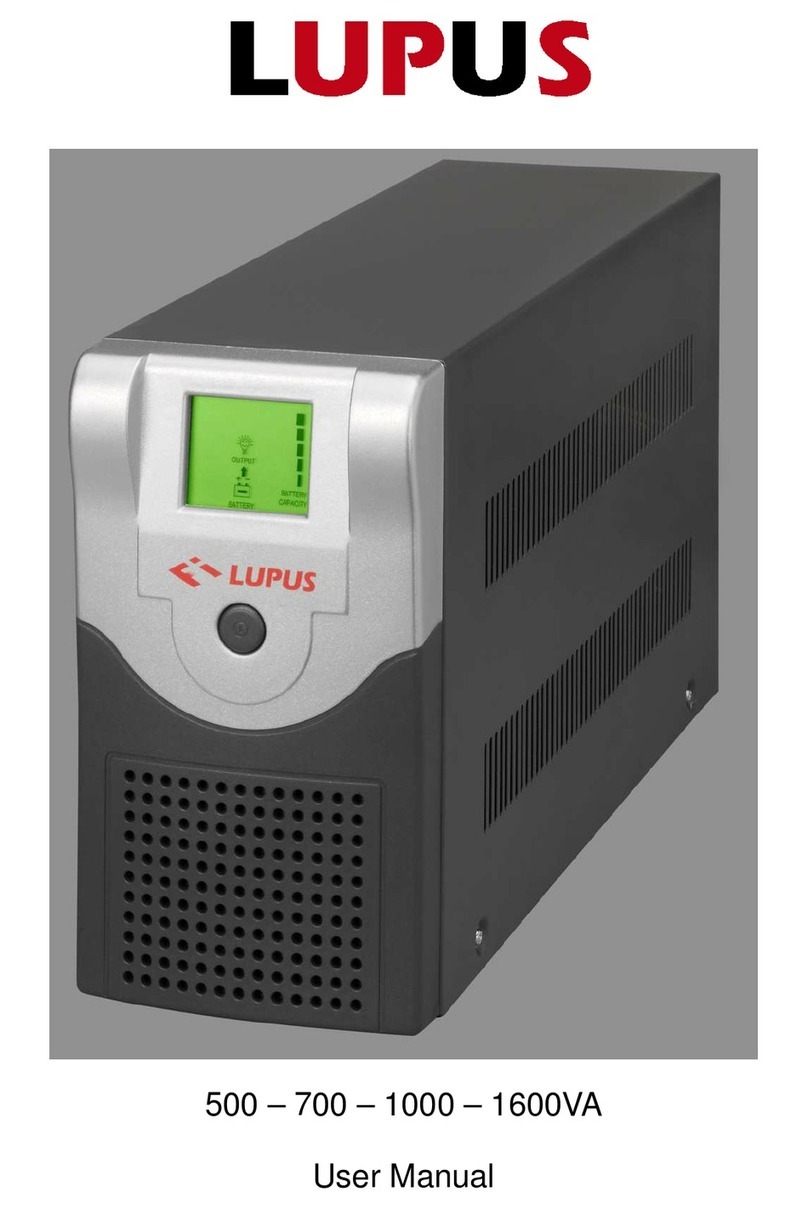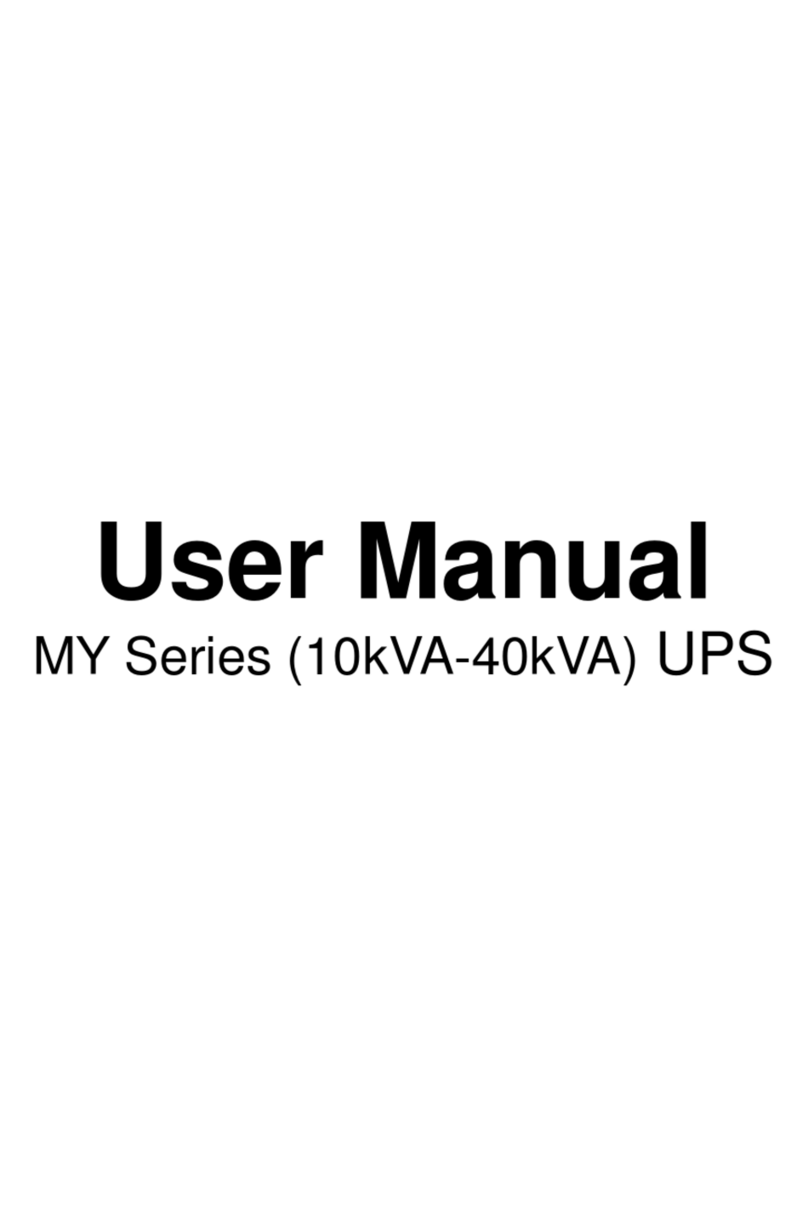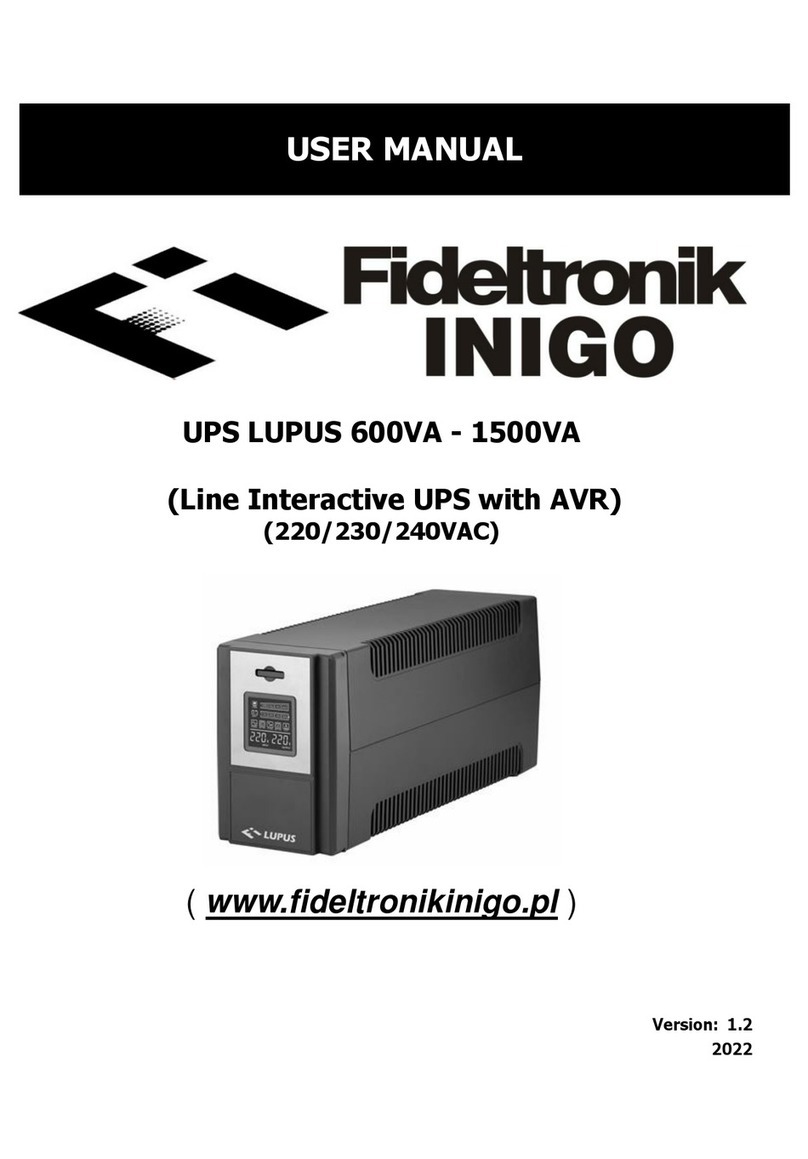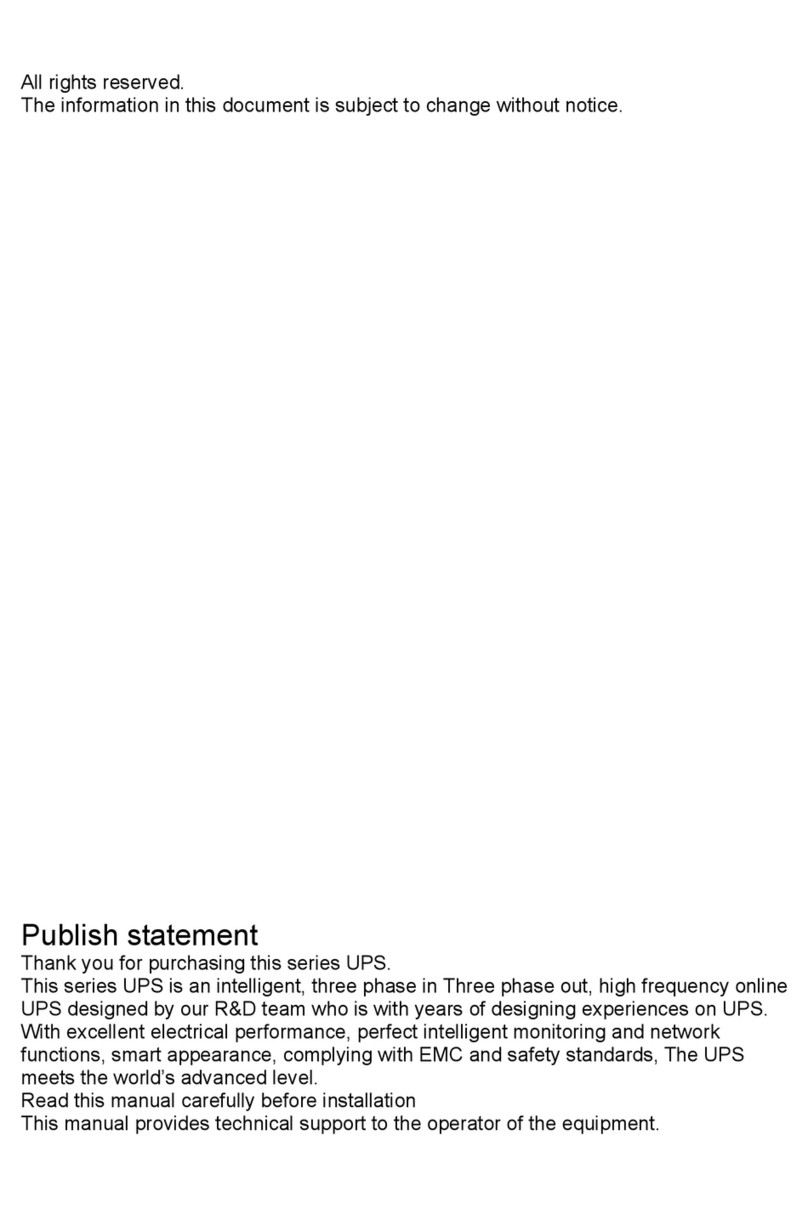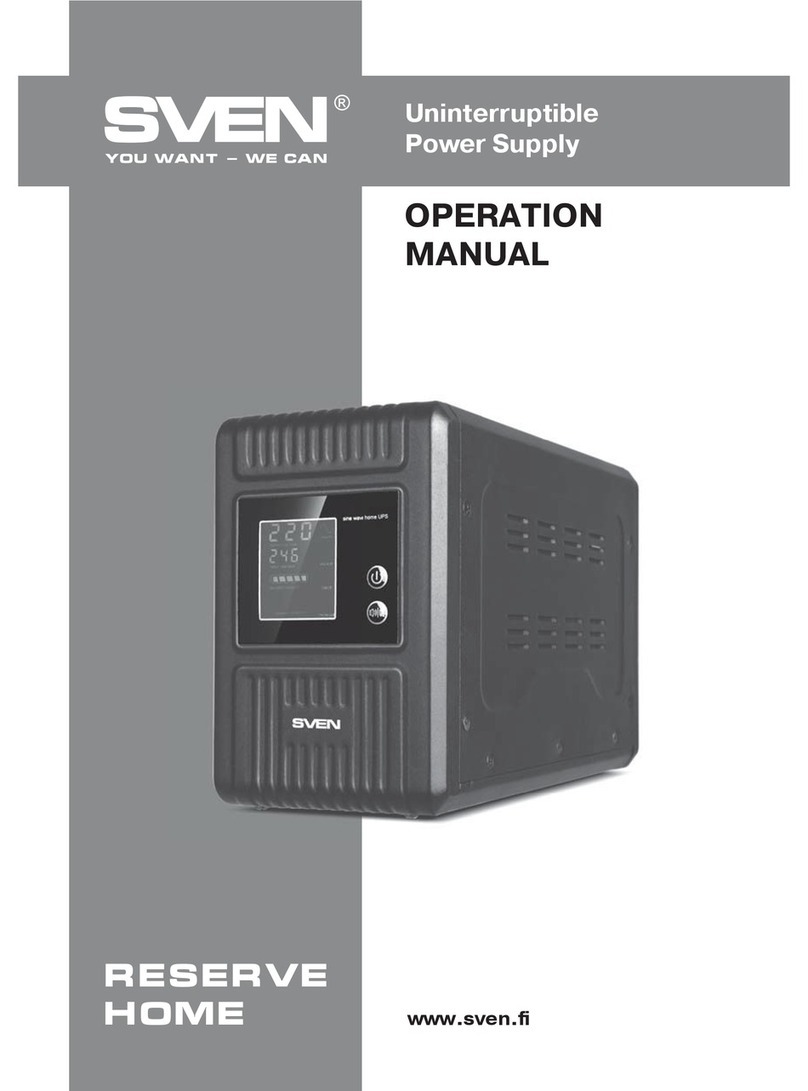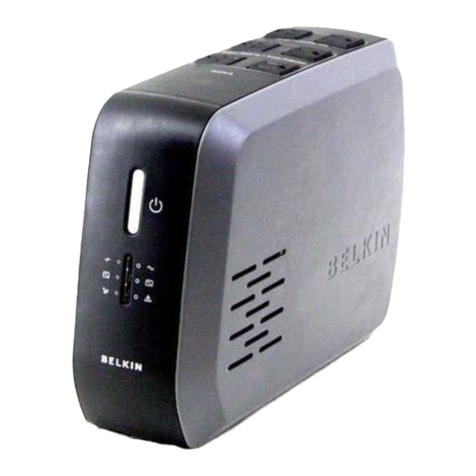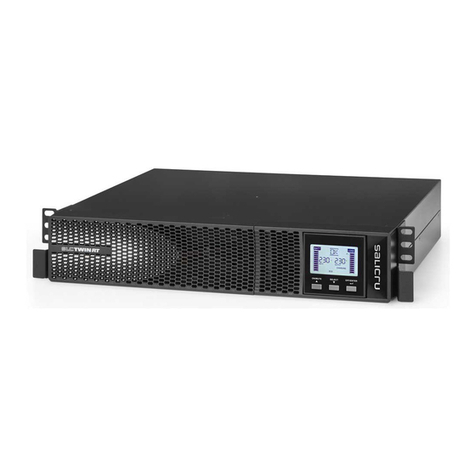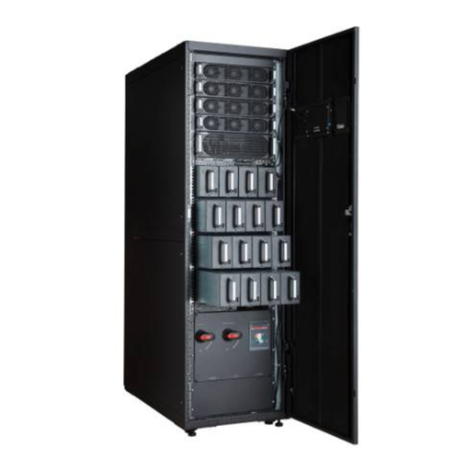Fideltronik Inigo KR 1000 RTC User manual

User’s Manual
KR RTC
1000VA / 2000VA /3000VA
Rack On-line UPS
www.fideltronikinigo.pl

Version K01-C000574-00

IMPORTANT SAFETY INSTRUCTIONS
1
This manual contains important instructions. Please read and follow all instructions carefully during installation and operation of the
unit. Read this manual thoroughly before attempting to unpack, install, or operate the UPS.
CAUTION! The UPS must be connected to a grounded AC
power outlet with fuse or circuit breaker protection. DO NOT
plug the UPS into an outlet that is not grounded. If you need to
power-drain this equipment, turn off and unplug the unit.
CAUTION! The battery can power hazardous components
inside the unit, even when theAC input power is disconnected.
CAUTION! The UPS should be placed near the connected
equipment and easily accessible.
CAUTION! To prevent the risk of fire or electric shock, install
in a temperature and humidity controlled indoor area, free of
conductive contaminants. (Please see specifications for
acceptable temperature and humidity range).
CAUTION! (No User Serviceable Parts): Risk of electric
shock, do not remove cover. No user serviceable parts inside.
Refer servicing to qualified service personnel.
CAUTION! (Non-Isolated Battery Supply): Risk of electric
shock, battery circuit is not isolated from AC power source;
hazardous voltage may exist between battery terminals and
ground. Test before touching.
CAUTION! To reduce the risk of fire, connect the UPS to a
branch circuit with 10 amperes (1000 / 2000) / 16 amperes
(3000) maximum over-current protection in accordance to CE
requirement.
CAUTION! The AC outlet where the UPS is connected should
be close to the unit and easily accessible.
CAUTION! Please use only VDE-tested, CE-marked mains
cable, (e.g. the mains cable of your equipment), to connect the
UPS to the AC outlet.
CAUTION! Please use only VDE-tested, CE-marked power
cables to connect any equipment to the UPS.
CAUTION! When installing the equipment, ensure that the
sum of the leakage current of the UPS and the connected
equipment does not exceed 3.5mA.
CAUTION! The 1000 / 2000 / 3000 / Battery module models
are only qualified maintenance personnel may carry out
installations.
CAUTION! Do not unplug the unit from AC Power during
operation, as this will invalidate the protective ground
insulation.
CAUTION! To avoid electric shock, turn off and unplug the
unit before installing the input/output power cord with a ground
wire. Connect the ground wire prior to connecting the line
wires!
CAUTION! Do not use an improper size power cord as it may
cause damage to your equipment and cause fire hazards.
CAUTION! Wiring must be done by qualified personnel.
CAUTION! DO NOT USE FOR MEDICAL OR LIFE
SUPPORT EQUIPMENT! Under no circumstances this unit
should be used for medical applications involving life support
equipment and/or patient care.
CAUTION! DO NOT USE WITH OR NEAR AQUARIUMS!
To reduce the risk of fire, do not use with or near aquariums.
Condensation from the aquarium can come in contact with
metal electrical contacts and cause the machine to short out.
CAUTION! Do not dispose of batteries in fire as the battery
may explode.
CAUTION! Do not open or mutilate the battery, released
electrolyte is harmful to the skin and eyes.
CAUTION! A battery can present a risk of electric shock and
high short circuit current. The following precaution should be
observed when working on batteries
1. Remove watches, rings or other metal objects.
2. Use tools with insulated handles.
CAUTION! The unit has a dangerous amount of voltage.
When the UPS indicators is on, the units may continue to
supply power thus the unit’s outlets may have a dangerous
amount of voltage even when it’s not plugged in to the wall
outlet.
CAUTION! Make sure everything is turned off and
disconnected completely before conducting any maintenance,
repairs or shipment.
CAUTION! Connect the Protection Earth (PE) safety
conductor before any other cables are connected.
WARNING! (Fuses): To reduce the risk of fire, replace only
with the same type and rating of fuse.
DO NOT INSTALL THE UPS WHERE IT WOULD BE
EXPOSED TO DIRECT SUNLIGHT OR NEAR A STRONG
HEAT SOURCE!
DO NOT BLOCK OFF VENTILATION OPENINGS AROUND
THE HOUSING!
DO NOT CONNECT DOMESTIC APPLIANCES SUCH AS
HAIR DRYERS TO UPS OUTPUT SOCKETS!
SERVICING OF BATTERIES SHOULD BE PERFORMED OR
SUPERVISED BY PERSONNEL KNOWLEDGE OF
BATTERIES AND THE REQUIRED PRECAUTIONS. KEEP
UNAUTHORIZED PERSONNEL AWAY FROM BATTERIES!

UNPACKING
2
UPS
User’s manual
Input power cord
Output power cord (optional)
Flat head screws: M4X8L (8)
Pan head screws: M5X12L (4)
Plastic washers (8)
Screw hole dust covers (8)
Rackmount ears (Stands) (2)
Install monitor software for optimal computer system protection,
install UPS monitoring software to fully configure UPS
shutdown. Please follow steps below to download and install
monitoring software from the internet:
1. Go to the website http://www.powermonitor.software/ or
https://www.powermonitor.software/#PowerMasterPlusSoftware
2. Click Power Master software icon and then choose your
required OS to download the software.
3. Follow the on-screen instructions to install the software

3
INSTALLATION
HARDWARE INSTALLATION
These versatile UPS systems can be mounted in a
rackmount or vertical tower orientation. This versatility is
especially important to growing organizations with changing
needs that value having the option to position a UPS on a
floor or in a rackmount system. Please follow the instructions
below for the respective mounting methods.
SAFETY PRECAUTIONS
CAUTION! To prevent the risk of fire or electric shock, only
use the supplied hardware to attach the mounting brackets.
RACKMOUNT INSTALLATION
Step 1: Rackmount ears installation
Attach the two rackmount ears to the UPS using the
provided screws M4X8L*8pcs.
Step 2: Rackmount rails Installation
1) The rails adjust to mount in 48-cm (19-inch)
panel racks from 52 to 91.5cm (20.5 to 36 inches)
deep. Select the proper holes in the rack for
positioning the UPS in the rack. The UPS takes up
position 1 through position 6.
2) Attach the rackmount rail to your rack with two
M5X12L screws and two plastic washers at the
front of the rack. (Located in position 1 &
position 6) Do not tighten the screws. Adjust the
rail size on the rail assembly of your rack. Secure
the rail to the rear of the rack with two M5X12L
screws and two plastic washers. Tighten all
screws at the front and rear of the rail. Once
completed, perform the same steps for
assembling the other rackmount trail.

INSTALLATION
4
Step 3: Install the UPS on the rack
Place the UPS on a flat stable surface with the front of the unit
facing toward you. Secure the UPS to your rack with four
M5X12L screws at the front of the rack. (Located in position 2 &
position 5).
VERTICAL/TOWER INSTALLATION
Step 1: Attach the base stands
Tighten the screws (M5X12*4pcs) of the base stands
(rackmount ears) onto the bottom of the UPS.
Step 2: Attach dust covers
Insert dust cover into the rackmount ear screw holes that are
not being used.

INSTALLATION
5
ELECTRICAL INSTALLATION
After completing the hardware installation of the UPS, you are now ready to plug in the UPS and connect your equipment.
SOFTWARE INSTALLATION
Power Master management software provides a user-friendly interface for your power systems. The graphic user-interface is
intuitive and displays essential power information at a glance. Please follow procedure below to install the software.
Installation procedure:
Download Power Master from the website: http://www.powermonitor.software/
Double-click the file and follow the installation steps.
When your computer restarts, the Power Master software will appear as a blue icon located in the system tray.
SAFETY PRECAUTIONS
CAUTION! Installation environment should be in a temperature and humidity controlled indoor area free of conductive contaminants.
Do not install this UPS where excessive moisture or heat is present (Please see specifications for acceptable temperature and
humidity range).
CAUTION! Never install a UPS, or associated wiring or equipment, during a lightning storm.
CAUTION! Do not work alone under hazardous conditions.
CAUTION! In case of the risk of electric shock, do not remove the top cover.
CAUTION! The battery can energize hazardous live parts inside even when the AC input power is disconnected.

INSTALLING YOUR UPS SYSTEM
6
SYSTEM BLOCK DIAGRAM
Output
Input
Filter
PFC
AC/DC BUS Inverter
DC/AC
INV
RY
Charger
AC/DC
Bypass
Battery
Output
Filter
Input
Line Mode
Battery Mode
Bypass Mode
Control
&
Monitoring
LCD Module
USB & DB9
SNMP Slot
DC/DC
HARDWARE INSTALLATION GUIDE
1.Battery charge loss may occur during shipping and storage.
Before using the UPS, it’s strongly recommended to charge
batteries for four hours to ensure the batteries’ maximum
charge capacity. To recharge the batteries, simply plug the UPS
into an AC outlet.
2.When using the included software, connect either the serial
or the USB cable between the computer and the corresponding
port on the UPS. Note: If the USB port is used, the serial port
will be disabled. They cannot be used simultaneously.
3.Connect your computer, monitor, and any externally-powered
data storage device (Hard drive, Tape drive, etc.) into the
outlets only when the UPS is off and unplugged. DO NOT plug
a laser printer, copier, space heater, vacuum, paper shredder or
other large electrical device into the UPS. The power demands
of these devices will overload and possibly damage the unit.
4.To protect a fax machine, telephone, modem line or network
cable, connect the telephone or network cable from the wall
jack outlet to the jack marked “IN” on the UPS and connect a
telephone cable or network cable from the jack marked “OUT”
on the UPS to the modem, computer, telephone, fax machine,
or network device.
5.Press the ON switch to turn the UPS on. If an overload is
detected, an audible alarm will sound and the UPS will
continuously emit one beep per second. For resetting the unit,
unplug some equipment from the outlets. Make sure your
equipment carries a load current within the unit’s safe range,
(refer to the technical specifications).
6.This UPS is equipped with an auto-charge feature. When the
UPS is plugged into an AC outlet, the battery will automatically
charge, even when the unit is switched off.
7.To maintain an optimal battery charge, leave the UPS
plugged into an AC outlet at all times.
8.Before storing the UPS for an extended period of time, turn
the unit OFF. Then cover it and store it with the batteries fully
charged. Recharge the batteries every three months to ensure
good battery capacity and long battery life. Maintaining a good
battery charge will help prevent possible damage to the unit
from battery leakage.
9. The UPS has one USB port (default) and one Serial port that
allows connection and communication between the UPS and
any attached computer running the Power Master software.
The UPS can control the computer’s shutdown during a power
outage through the connection while the computer can monitor
the UPS and alter various programmable parameters.
Note: Only one communication port can be used at a time. The
port not in use will automatically become disabled or the serial
port will be disabled if both ports are attached.
10.EPO (Emergency Power Off) / ROO(Remote on/off) Port:
EPO/ROO ports allow administrators the capability to connect
the UPS unit to customer-supplied EPO/ROO switches. If EPO
is enabled, these installations give operators a single access
point to immediately power-off all equipment connected to the
UPS during an emergency. If ROO is enabled, these
installations give operators a access point to turn on/off UPS
remotely.
11.To avoid electric shock, turn the unit OFF and disconnect
the unit from utility power before hardwiring the UPS (in/out
power cord). The in/out power cord MUST be grounded.

BASIC OPERATION
7
POWER MODULE FRONT/REAR PANEL DESCRIPTION
1. Power On/Off Button
Master ON/OFF for the UPS.
2. Function Buttons
Scroll up, scroll down, select and cancel LCD menu.
3. Multifunction LCD Readout
Indicate status information, settings and events.
4. AC Input Inlet
Connect the AC Power cord to a properly wired and
grounded outlet.
5. Input Circuit Breaker
Provide input overload and fault protection.
6. EPO (Emergency Power Off) Connector
Enable Power-Off in emergency from a remote
location.
7. USB port
This is a connectivity port which allows communication
and control between the UPS and the connected
computer. It is recommended to install the Power
master software on the PC/Server connected with the
USB cord.
8. Serial Port
Serial port provides communication between the UPS
and the computer. The UPS can control the computer’s
shutdown during a power outage through the
connection while the computer can monitor the UPS
and alter its various programmable parameters.
9. SNMP/HTTP Network slot
Slot to install the optional SNMP card for remote
network control and monitoring.
10. Battery Backup & Surge Protected Outlets
Provide battery backup and surge protection. They
ensure power is provided to connected equipment over
a period of time during a power failure.
11. Extended Runtime Battery Module Connector
Connect to additional external battery modules.
Front view KR RTC 1000/2000/3000 VA
Back view KR RTC 1000VA-3Batt. /2000VA-4Batt.
Back view KR RTC 3000VA-6Batt.
BATTERY MODULE FRONT/REAR PANEL DESCRIPTION
1. Input Connector
Use this input connector to daisy chain the next Battery
module. Remove the connector cover for access.
2. On-board Replaceable Fuse Cover
Replaceable fuse is accessible from the rear panel. It
must be done by qualified personnel.
3. Output Connector
Use this output Connector to connect the Battery
module to the Power module or to the next Battery
module.
External Battery Bank for 24V/36V/48V/72V ups

BASIC OPERATION
8
CONNECTION #1 : POWER MODULE WITH ONE
BATTERY MODULE
Rotate the battery cable retention bracket and tighten
the two screws to fix battery cable.
CONNECTION #2 : POWER MODULE WITH
MULTIPLE BATTERY MODULES
Step 1: Use the battery cable to connect the 2nd Battery
module to the 1st Battery module.
Step 2: Rotate the battery cable retention bracket and tighten
the two screws to fix battery cable.
Battery Installation and replacement
Step 1: Remove the front panel. Remove the retaining
screws from the battery bracket and then remove the cover
itself. undraw the connectors.
Step 2: Pull the battery tray out slowly. Put the new battery
tray back into the compartment after that.
Step 3: Fasten the battery bracket and then insert the
connectors. Place the connectors in the bracket.
Step 4: Tighten the screws of the battery bracket and front
panel .

9
BASIC OPERATION
DEFINITIONS FOR OTHER ICONS
MUTE: This icon appears whenever the UPS is in silent mode. The alarm does not
beep during silent mode until the battery reaches low capacity.
SCHEDULE: Users can setup the schedule to turn on and shut down the computer
and UPS through Power Master software. The LCD display will show how much
time is left before the UPS will turn back on or shut down.
FAULT: This icon appears if there is a problem with the UPS.
Setting mode
+
ECO mode
Bat mode
** When this icon is blinking,the batteries need to be replaced.
Line mode: lighting
Converter mode: blinking
+
Bypass mode
Load capacity
Battery capacity:
Bat mode: battery capacity
Line mode:
1. Battery charging: cycle lighting
2. Battery full charged: lighting
3. Line mode without charger: battery capacity

BASIC OPERATION
10
OUTPUT Program:indicate the status of outlets, if NCL outlets is enable, “ ” will
be lighting, if NCL outlets is disable, “ ” will be off.
OUTPUT Program:indicate the status of outlets, if critical output outlets is enable,
“ ” will be lighting, if critical output outlets is disable, “ ” will be off.
**) When operating in ECO Mode, the efficiency of UPS is higher than that in online mode, but transfer time should not be 0ms
**) When operating in Converter Mode, the frequency of output should be always 50Hz or 60Hz, but load capacity will be
derated.
LCD SCREEN –UPS STATUS
Operation mode
Description
LCD display
Line mode
Utility will provide energy to loads. It will
also charge the batttery at the same time.
Standby mode
UPS is powered off without output power,
but the battery still can be charged.
Battery mode
The unit will provide output power from
battery.
ECO mode
When the input voltage is within voltage
regulation range, UPS will bypass voltage to
output for energy saving.

BASIC OPERATION
11
Bypass mode
When the input voltage is within bypass
voltage range, UPS will bypass voltage to
output.
Converter mode
is blinking
When input frequency is within 40Hz to
70Hz, the UPS can be set at a constant
output frequency, 50Hz or 60Hz.
Fault mode
The UPS is in fault mode, and user can
check the fault code on the LCD display.

BASIC OPERATION
12
Event ID Descriptions
Event ID
Description of Cause
E01
Bus Start Fail: DC-DC converter or bus sensing circuit failed.
E02
Bus Volt High: DC-DC converter failed.
E03
Bus Volt Low: DC-DC converter failed.
E04
Bus Unbalanced: DC-DC converter failed.
E06
INV Start Fail: Inverter circuit failed.
E07
INV Volt High: Inverter circuit or output voltage sensing circuit
failed.
E08
INV Volt Low: The load may be too heavy or inverter circuit failed.
E09
INV Short: The inverter circuit failed.
E11
Bat Volt High: The external battery module connection is wrong, or
the charger failed.
E12
Bat Volt Low: Batteries failed.
E14
Over Load: UPS is overloaded.
E18
Fan Fail: The ventilation hole has been covered, or the fans can’t
work.
E19
Over Temperature: High ambient temperature, or the ventilation
hole has been covered.
A56
Bat Volt Low: Battery voltage is low.
A57
Bat Cap Low: Battery capacity is low.
A59
Bat disconnect: Battery is disconnect.
A60
Overcharge: Charger voltage is high.
A61
Charger fail: Charger is failed.
A62
Bat Bad: Battery failed.
A64
Over Load warning: UPS is overload.
A66
EPO Off: Missing the EPO connection
A68
High Temperature: High ambient temperature, or the ventilation
hole has been covered. This is shown only when start up UPS.
A69
Fan Lock: fans can’t work because of lock.
BUTTON OPERATION
Button
Operation Description
ON
Press this button to turn on UPS.
In line mode, ECO mode, or converter mode, press the “ON” button for
5 seconds to activate the battery test.
OFF
Press this button to turn off UPS.*
ENTER
Press this button for 5 seconds to get into setting mode while in
bypass mode, or standby mode.
In setting mode, press this button to confirm selection, or press this
button for long time to exit setting mode and saving changes.
ESC
In setting mode, press this button to display next selection, or press
this button for long time to exit setting mode without saving changes.
Press the “ESC” button for 5 seconds to disable and enable buzzer
alarm.
ENTER + ESC
Switch to bypass mode: When the main power is normal, press these
two buttons simultaneously for 5 seconds, then UPS will enter to
bypass mode.
ON + ENTER
Rotate the LCD display: if user want to change LCD to tower display,
press these two buttons simultaneously for 5 seconds

13
BASIC OPERATION
LCD SETTINGS CONFIGURATION
There are 9 UPS settings that can be configured by the user.
1. Press the “ENTER” button for 5 seconds to activate the setting mode.
The first configuration parameter will be displayed on the LCD screen.
Note: The manual settings programming mode can ONLY be invoked while UPS is in Bypass mode or Standby mode. To
make UPS on Standby mode or Bypass mode, connect utility power to UPS and do not turn on UPS.
2. Press the “ENTER” button to select the setting you want to configure.
3. Press the “ENTER” buttons to scroll through the different parameters and select the parameter you want.
4. Press the “ESC” button for 5 seconds to cancel and exit setting mode. Press the “ENTER” button for 5 seconds to
save all the settings you just do and exit setting mode.
5. In any mode(Except setting mode), Press the “ESC” button for 5 seconds to disable and enable buzzer alarm
Setting
item
Configure
Submenu
Available Settings
Default Setting
LCD Display
001
Output
Voltage
=[208V] [220V][230V] [240V]
230V
002
Output
Frequency
= [50Hz][60Hz]
50Hz
003
ECO Mode *
[0%] (Disable) [10%][15%] (Enable)
0%
004
Bypass Mode
**
[DIS] (Disable) [ENA] (Enable)
Enable
005
Converter
Mode
[DIS] (Disable) [ENA] (Enable)
Disable
006
EPO/ROO***
[EPo] /[Roo]
EPO
007
EBM
Number****
[0bP]/[1bP]/[2bP]/[3bP]/[4bP]/[5bP]
/[6bP]/[7bP]/[8bP]/[9bP] /[AbP]
0(for standard models)
/ 1 (for long-run
models)
008
Bypass when
UPS is Off
[DIS] (Disable) [ENA] (Enable)
Disable
009
Buzzer
[DIS] (Disable) [ENA] (Enable)
Enable

BASIC OPERATION
14
010
NCL
Output*****
[DIS] (Disable) [ENA] (Enable)
Enable
*) When operating in ECO Mode, the efficiency of UPS is higher than that in online mode, but transfer time should not be 0ms
**) When operating in Converter Mode, the frequency of output should be always 50Hz or 60Hz, but load capacity will be derated
by 40%.
*) This function would be set as 0% when Converter Mode is enabled.
**) UPS has no bypass when Converter Mode is enabled.
***) ROO (Remote On/Off): If ROO is enabled, UPS can be turn on/off by the ROO port. If ROO port is disconnected, UPS will be
turned off. If ROO port is connected, UPS will be turned on when the utility is normal
****) 1. UPS cannot detect the numbers of external battery automatically, so manual input from user is necessary.
2. For standard models, the maximum number is prefer to 1. For long run models, the maximum number is just 1 EBM, the
charge current will be 4A, if EBM number is over 1, the charge current will be 8A

MAINTENANCE
15
Storage
To store your UPS for an extended period, cover it and store
with the battery fully charged. Recharge the battery every
three months to ensure battery life.
Safety Precautions
CAUTION! Only use replacement batteries which are
certified by your dealer. Use of incorrect battery type is an
electrical hazard that could lead to explosion, fire, electric
shock, or short circuit.
CAUTION! Batteries contain an electrical charge that can
cause severe burns. Before servicing batteries, please
remove any conductive materials such as jewelry, chains,
wrist watches, and rings.
CAUTION! Do not open or mutilate the batteries.
Electrolyte fluid is harmful to the skin/eyes and may be toxic.
CAUTION! To avoid electric shock, turn off and unplug the
UPS from the wall receptacle before servicing the battery.
CAUTION! Only use tools with insulated handles. Do not
lay tools or metal parts on top of the UPS or battery terminals.
Replacement Batteries
Please refer to the front side of the UPS for the model
number of the correct replacement batteries. For battery
procurement, contact your local dealer.
Battery Disposal
Batteries are considered hazardous waste and must be
disposed of properly. Contact your local government for more
information about proper disposal and recycling of batteries.
Do not dispose of batteries in fire.

TECHNICAL SPECIFICATIONS
16
Model
1000 RTC
2000 RTC
3000RTC
Capacity (VA/W)
1000VA/900W
2000VA/1800W
3000VA/2700W
Configuration
Form Factor
Rack
Energy-saving
Technology
Yes, ECO Mode Efficiency ≧95%
Input
Voltage Range
80~300Vac5% for 1000/2000/3000VA model
@ 0~30% Load5%
120~300Vac5%for 1000/2000VA model
140~300Vac5%for 3000VA only
@ 30~60%Load5%
140~300Vac5%for 1000/2000VA model
160~300Vac5% for 3000VA only
@ 60~80%Load5%
160~300Vac5%for 1000/2000VA model
190~300Vac5% for 3000VA only
@80~100%Load5%
Frequency Range
40~70Hz
Power Factor
0.99
Cold Start
Yes
Output
Output Voltage
208/220/230/240Vac±1%
Output Waveform
Pure Sine Wave
Output Frequency
50 / 60Hz (Auto-Sensing or Configurable) ±0. 5Hz*
Transfer Time (Typically)
0ms
Rated Power Factor
0.9
Harmonic Distortion
THD < 3% at Linear Load, < 5% at Non-linear Load @ Nominal Input
Crest Factor
3 : 1
ECO Mode
Voltage Regulation
±10%, ±15% (Configurable)
Overload
Protection
Line
Mode
105~110% Overload warning only (No shutdown)
110~120% Warning, transfer to bypass after 60s
>120%Transfer to bypass immediately
Battery
Mode
105~110% Overload warning only (No shutdown)
110~120% Warning, shutdown after 10s
>120%Shutdown immediately
Short Circuit Protection
UPS Output Cut off Immediately or Input Fuse / Circuit Breaker Protection
Surge Protection
IEC 61000-4-5 Level 4
Battery
Model Name
1000R-3Batt.
2000R-4Batt.
3000R-6Batt.
Battery Voltage
36V
48V
72V
Battery Type
12V/7AH
12V/9AH
12V/9AH
For long-run Models, NO Battery Inside.
Recharge Time
(Typically)
4 Hours (inside batteries)
Sealed, Maintenance Free
Yes
Status Indicators
LCD Screen
Graphic LCD
Audible Alarms
Battery Mode, Battery Low, Overload, UPS Fault, Replace Battery, Bypass Mode
Charger Failure /Over Charged, Fan failure, EPO active
Environment
Operating Temperature
32℉to 104℉( 0℃to 40℃)
Operating Relative
Humidity
20 to 90% Non-Condensing
Management
On-Device Features
Self Test, Auto-Charge, Auto-Restart, Auto-Overload Recovery
Connectivity Ports
(1) Serial Port (RS232), (1) USB Port,
SNMP/HTTP Capable
(1) Expansion Port (With optional card)

TECHNICAL SPECIFICATIONS
17
*) Within 50/60Hz±8% by default, the output frequency is synchronization with input mains. User can adjust the acceptable range for
output frequency (±1, 2, 3, 4, 5, 6, 7, 8, 9, 10%). When input frequency is out of synchronization window but within 40-70Hz, UPS
can stay in line mode and output frequency is regulated at 50/60Hz+0.5% with load derating by 40%.
Software
Power Management
Software
Power Master
Physical
Dimensions (H x W x D)
.88×438×430 mm
88×438×430 mm
88×438×610 mm
Net Weight
13.67
17.32
27.34

18
TROUBLE SHOOTING
Problem
Possible Cause
Solution
Warning
O/P Overload
Your equipment requires more power than the
UPS can provide. If the UPS is in Line Mode
then it will transfer to Bypass Mode; if the UPS is
in Battery Mode it will shutdown.
Shut off non-essential equipment. If this solves
the overload problem, the UPS will transfer to
normal operation.
Battery Mode
UPS is operating on battery power.
Save your data and perform a controlled-
shutdown.
Battery Low
UPS is operating on battery power and will be
shutting down soon due to extremely low battery
voltage.
UPS will restart automatically when acceptable
utility power returns.
BAT Disconnected/
Battery Replace
Missing battery power.
Check battery connector when use battery
packages.
UPS has failed in Battery Test.
Contact technical support to replace the battery.
Charger Failure
Charger has failed.
1. Shut down UPS and turn off AC input.
2. Contact your dealer for repair.
EPO OFF
Missing the EPO connection.
Check the EPO connection.
Fault
Over Temperature
High ambient temperature.
1. Shut down UPS. Restart UPS to Check the
fan for operation and if the ventilation hole has
been covered
2. Contact your dealer for repair.
Output Short
Output short circuit.
1. Shut down UPS
2. Your attached equipment may have problems,
please remove them and check again.
High O/P V
Output voltage is too high.
1. Shut down UPS
2. Contact your dealer for repair.
Low O/P V
Output voltage is too low.
Bus Fault
Internal DC bus voltage is too high or too low.
Other
Startup fail
High temperature, or fan fail, or battery low, or
EPO off.
1. Restart UPS and press the “ESC” button to
view the warning event. Then refer to the solution
for the warning.
2. Contact your dealer for repair.
All rights reserved. Reproduction without permission is prohibited.
This manual suits for next models
2
Table of contents
Other Fideltronik Inigo UPS manuals
Popular UPS manuals by other brands
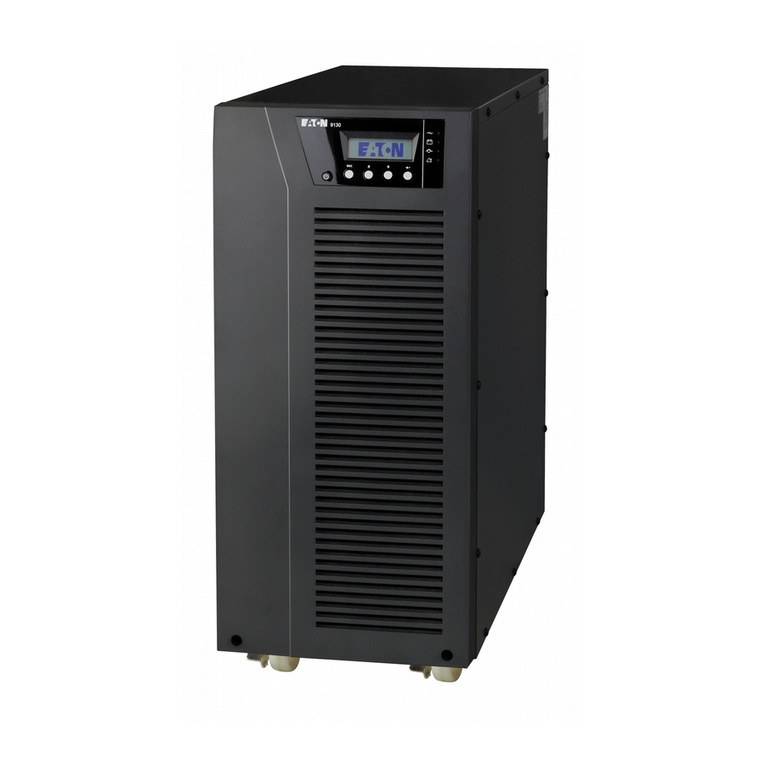
Eaton
Eaton Powerware 9130 user guide
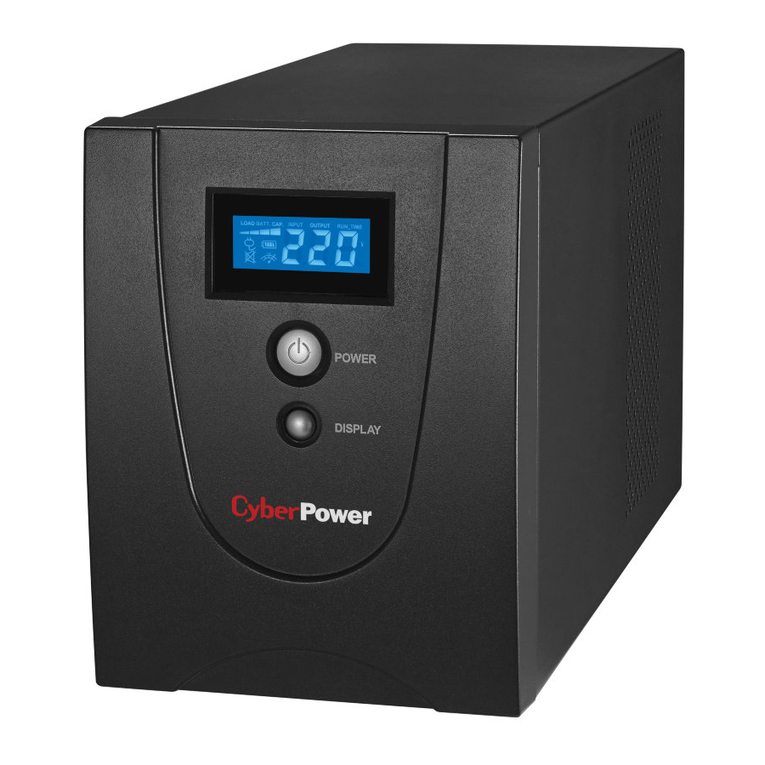
CyberPower
CyberPower Value1200EILCD user manual
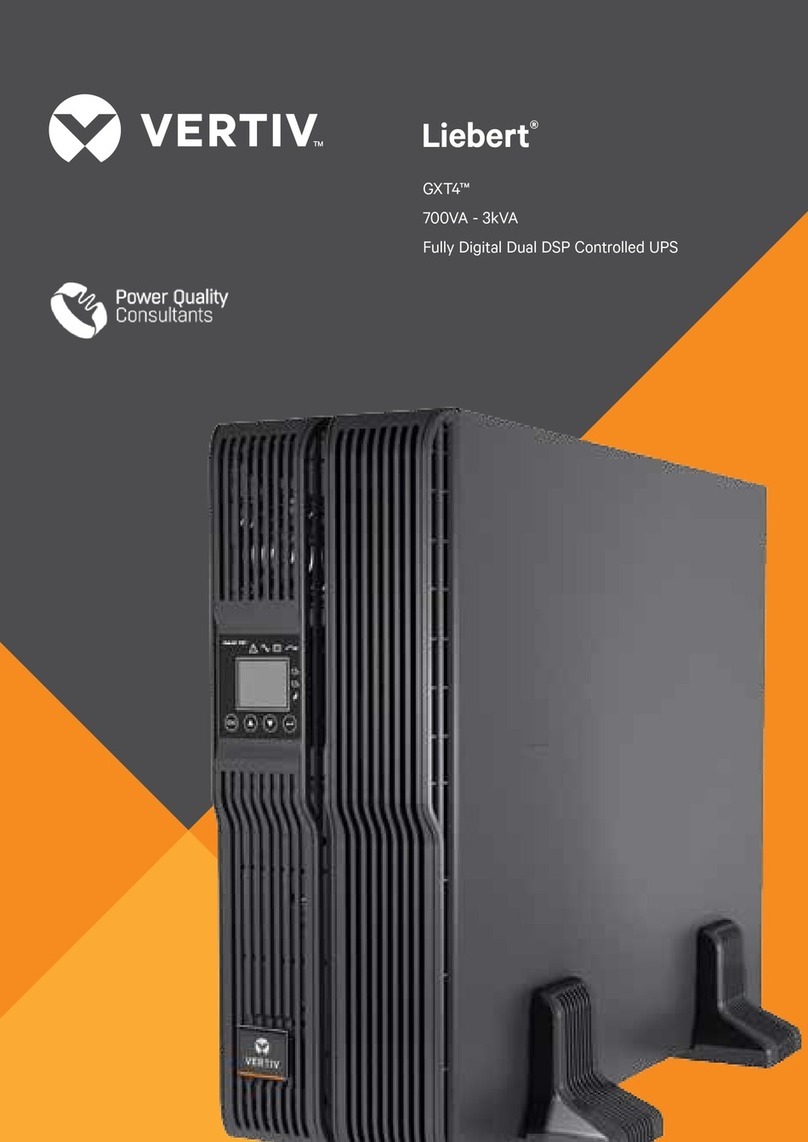
Vertiv
Vertiv Liebert GXT4 Series quick start guide

Omron
Omron BU5002R instruction manual

Powerware
Powerware Uninterruptible Power Supply Installation and operation manual
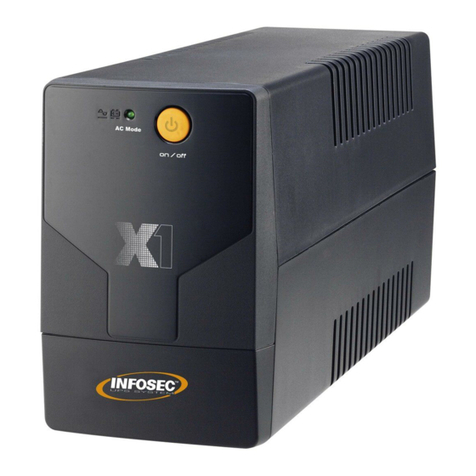
INFOSEC UPS SYSTEM
INFOSEC UPS SYSTEM X1 EX Series user guide
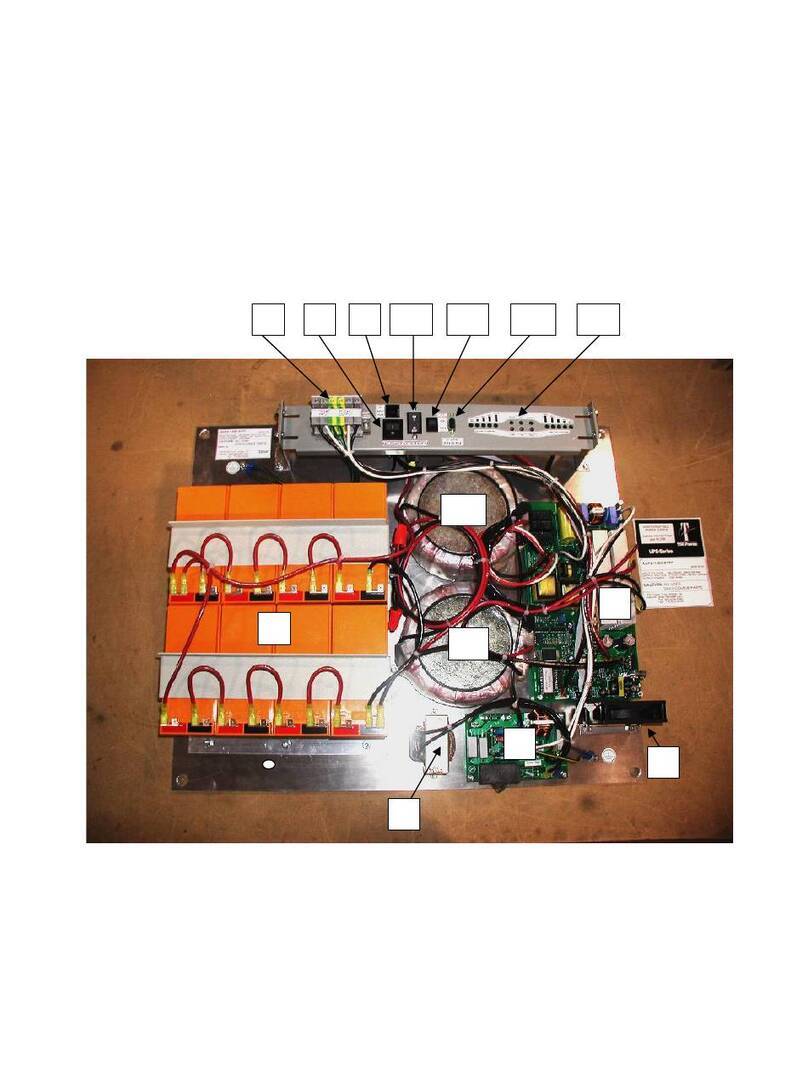
TSi Power
TSi Power XUPS-1500-8777 OPERATING & SERVICE MANUAL
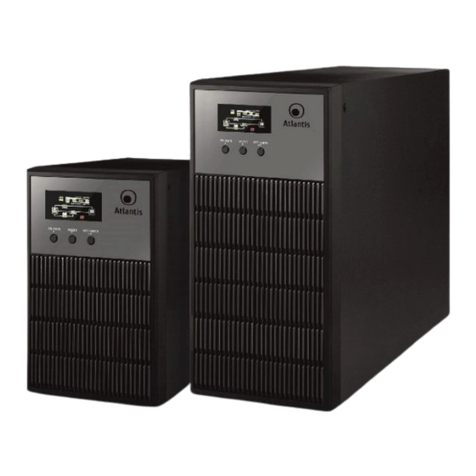
Atlantis
Atlantis A03-OP1001 user manual
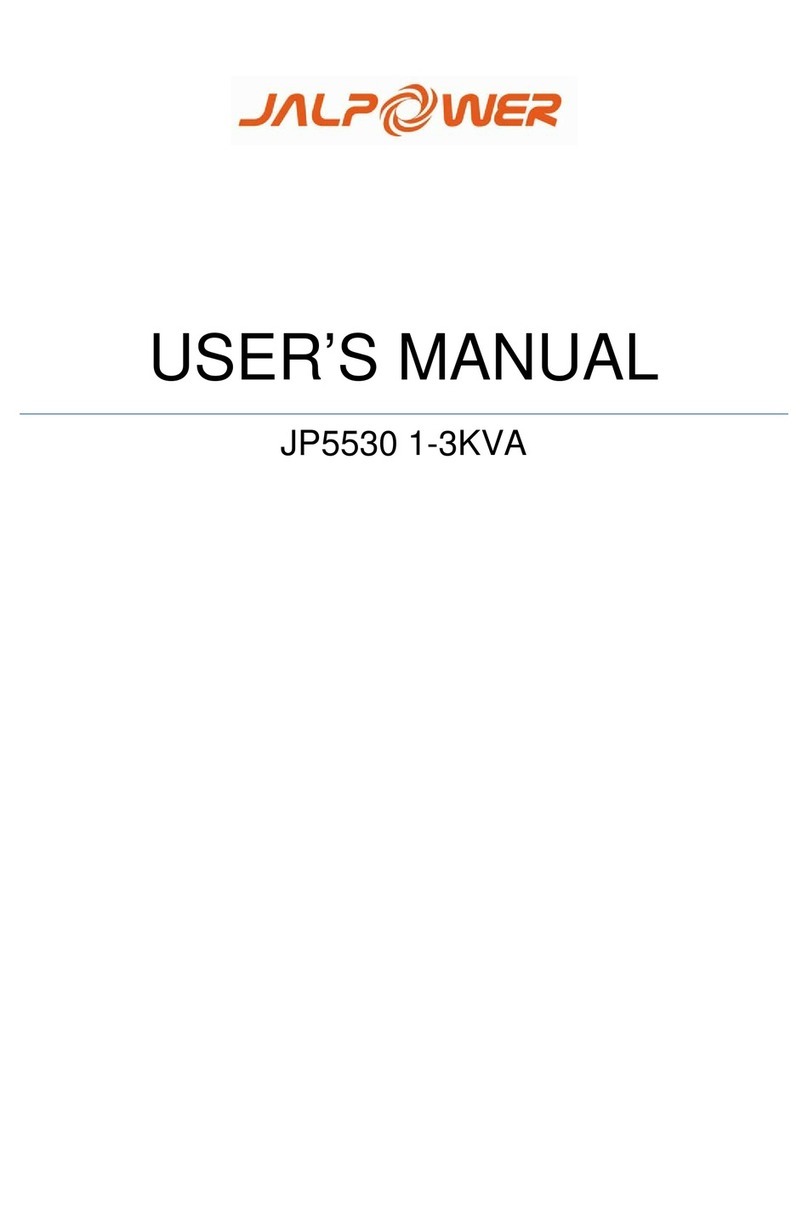
JALpower
JALpower JP5530 Series user manual
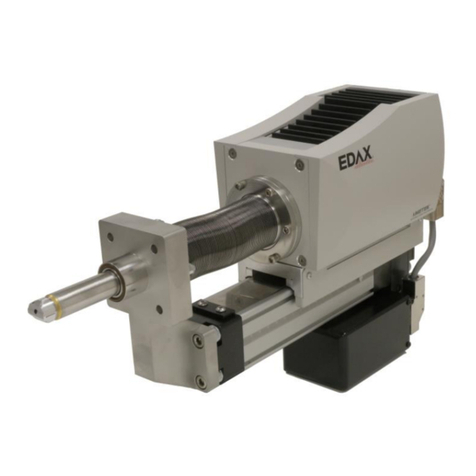
Metek
Metek Apollo XF Octane user guide
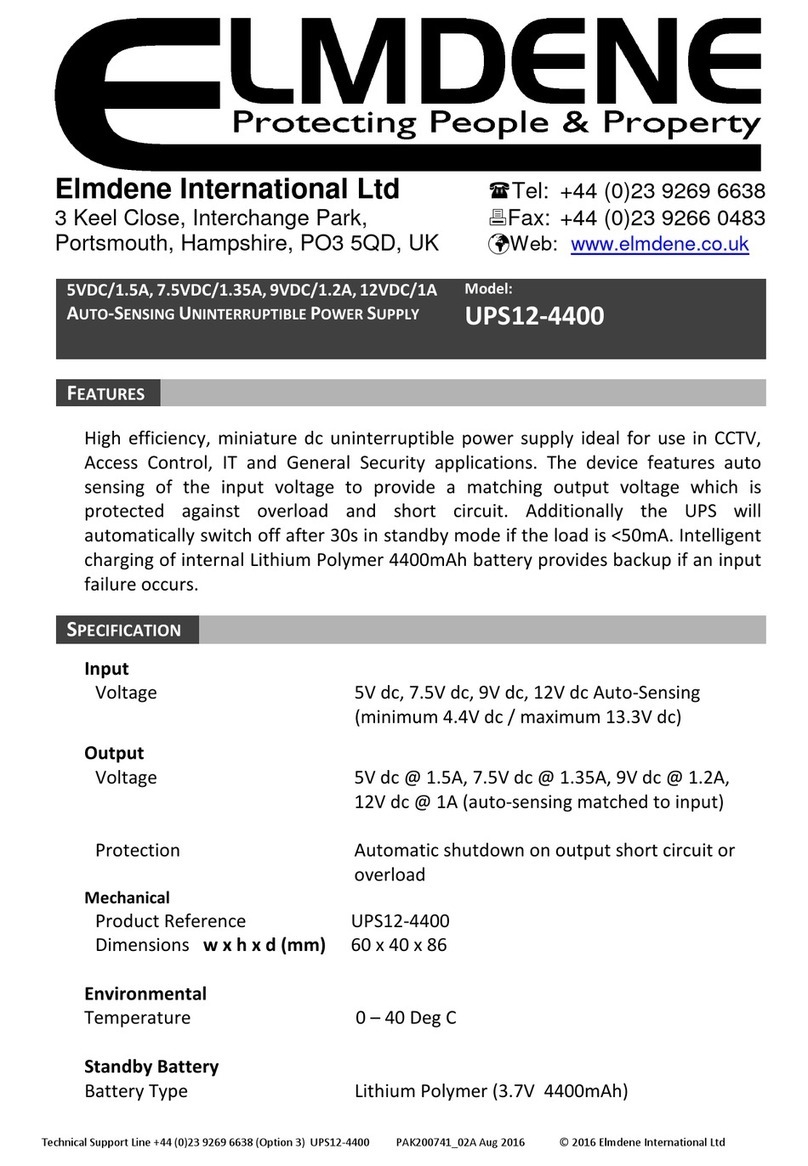
Elmdene
Elmdene UPS12-4400 instruction sheet
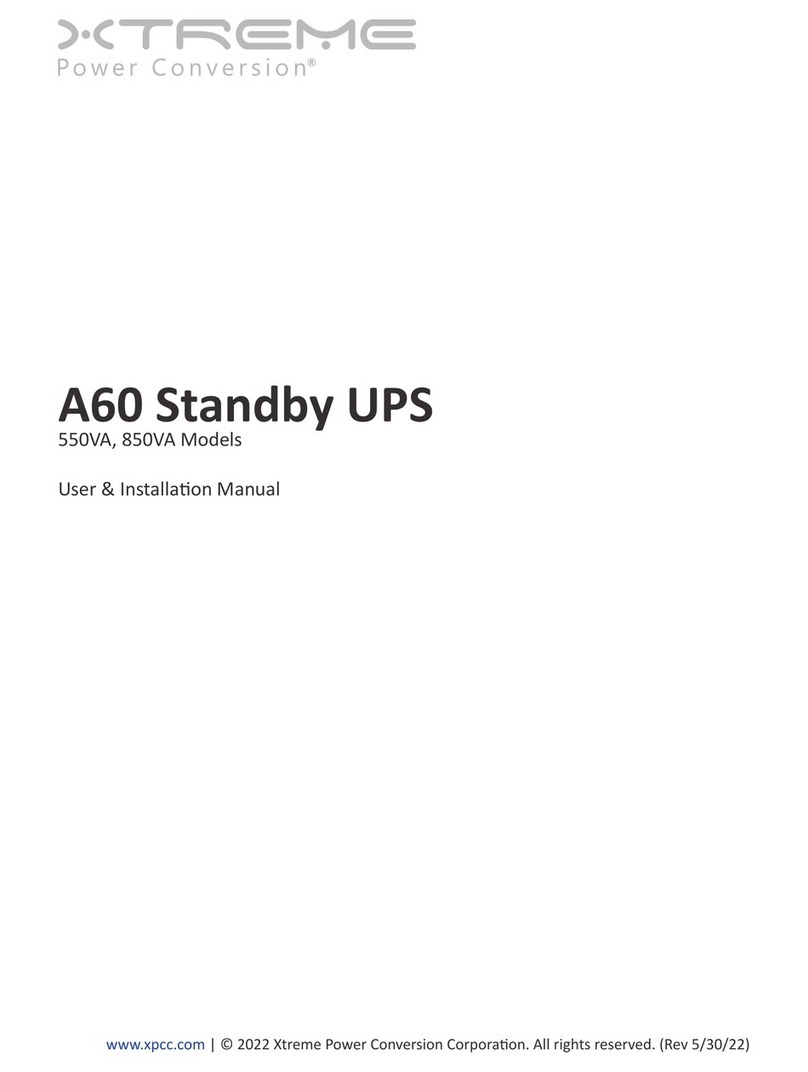
Xtreme Power Conversion
Xtreme Power Conversion A60 Standby User & installation manual
